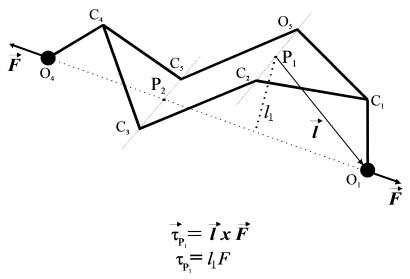Figure 1.
A simplified mechanical model of the pyranose ring. An external force (F) is applied to the ring through the oxygen atoms O1 and O4 as in an (1a → 4e)-linked polysaccharide chain (e.g., amylose). The direction of F coincides with the direction of the residue vector O1O4. The force applied to the axial oxygen O1 has a large torque τP1 relative to the pivot point P1 (P1 lies on the imaginary axis of rotation passing through C2 and O5) and promotes a transition of the ring to the boat conformation. The axial bond C1O1 works as a lever arm. The force applied to the equatorial oxygen O4 has a negligible torque relative to P2 (P2 lies on the imaginary axis of rotation that passes through C3 and C5) because its line of action passes in the vicinity of P2. Therefore the equatorial bond cannot mediate a conformational transition; however, a force applied to it will strain the ring. (Inset) Definition of torque as the cross product between the distance vector l and the force vector F.

